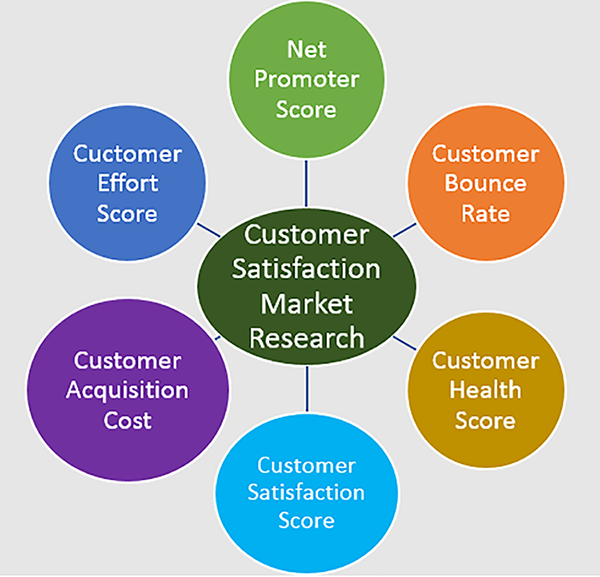Customer Satisfaction – 6 Key Customer Satisfaction Metrics to Understand Your Customers
You should never underestimate the importance of customer satisfaction. Customer satisfaction is one of the many factors that contribute to the success or failure of a business. Key Customer satisfaction metrics provide a measure to keep track of your clients. This transforms a majority of your customers into repeat customers. Hence, higher loyalty towards your brand. Satisfied customers become your brand ambassadors attracting more customers to your business. If you do not pay attention to your customers’ satisfaction, you should not expect the customers to pay attention to your brand. It is crucial for a business to be customer-centric and assess customer satisfaction regularly.
There are 6 key customer satisfaction metrics that are important in understanding customers:
Customer Net Promoter Score
Customer net promoter scores one of the common indexes among the 6 customer satisfaction metrics. Its measure ranges from -100 to 100. The index measures the willingness of customers to recommend a company’s products to other customers. Net promoter score assesses a customer’s overall satisfaction. It also measures customer’s loyalty to a particular brand. Customers are asked to rate the likelihood of recommending a brand or a company to a friend or colleague. When assessing customers, a question may read: “On a scale of 0 to 10, how likely are you to recommend products to a friend or colleague?”
Based on their responses, customers are grouped into three categories. The categories are;
- Detractors
- Passives
- Promoters
Detractors
Customers who give a score lower or equal to 6. This category means that customers are not happy or thrilled with the product. It also means that the customers are not likely to purchase the products under review. The customers are also expected to tarnish the reputation of the company through negative word-of-mouth.
Passive
Customers who give a score 7 or 8. Passives are somehow happy and satisfied with the products. Besides, they can also readily embrace a competitor’s offering if they get a chance. Passives are not likely to spread negative word-of-mouth about a company’s products. However, they do not see a reason that can compel then into promoting products. They are not very happy with them.
Promoters
Customers with scores of 9 or 10. These customers are happy and love a company’s products and services. They are enthusiasts who recommend a company’s products and services to their friends and colleagues.
To get the Net Promoter Score (NPS), you subtract the percentage of detractors from the percentage of promoters. You get a score ranging between -100 to 100. If all customers give a score lower or equal to 6, this would be an NPS of -100. If all customers gave ratings of 9 or 10, this would be an NPS of 100.
Satisfaction Score
Of all the customer survey methodologies, customer satisfaction score is the most straightforward. The score is commonly abbreviated as CSAT. It helps assess a customer’s satisfaction with a business, purchase, or interaction. When assessing satisfaction, you may ask a question like: “How happy are you with our product or service?” The score uses a survey scale that may range from 1-3, 1-5, or 1-10. The most significant advantage of the customer satisfaction score is its simplicity.
You can track customer satisfaction across the customer’s life cycle at the company. If you learn that the customer’s experience was not satisfactory, you can take the necessary actions immediately. The score helps you to identify potential bottlenecks and correct them.
Due to the simplicity of the score, it is possible to conduct the customer satisfaction survey regularly. This can also be at many touchpoints. You can deploy customer satisfaction surveys on a rolling basis to get constant feedback about your company offering.

Customer Acquisition Cost
Customer acquisition cost (CAC) is a commonly used metric among the 6 key customer satisfaction metrics to assess customers’ satisfaction level. The CAC refers to the cost of convincing a customer to buy a product or a service. The CAC metric can help a company determine the return on advertising investment.
You can measure CAC by dividing the entire cost of acquiring more customers with the number of customers acquired during the period under review. For instance, if a company spends $200 on marketing in a year and acquires 200 customers in a year, the company’s CAC is $1.00.
When using this metric, you should be aware of some caveats. For instance, if a company is conducting marketing in a new region, the number of customers acquired may be lower. The marketing efforts may bear more fruits in the future. This is because a majority of customers getting familiar with a company offers. Besides, when carrying out online marketing through SEO. For instance, you may not see the results immediately until a later date.
When you are operating a business, two factors matter more than anything else. These factors include how much it costs you to attain your customers (CAC) and your customers’ lifetime value (LTV). LTV is how much the customers will spend with you over their lifetime.
There is no better way to lower your CAC and to increase your LTV than focusing on making your customers happy. Satisfied and happy customers will spread the good word about your business and acquire more customers for you. You will not have to spend too much on marketing to acquire new customers.
Customer Effort Score
Using customer effort score (CES), you can measure customer satisfaction using one main point/question. The critical point is that companies develop loyal customers by lowering/reducing customer efforts. A CES measures how much effort a customer has to exert to get a request fulfilled, an issue resolved, a question answered, or an item purchased or returned.
Typically, CES asks questions and customers answer on a scale ranging from very easy to very difficult. Customers tend to be more loyal to a product or a service that is easier to use or access. CES score serves as a significant indicator of customers’ loyalty.
A CES survey is easy to deploy and track overtime, and this makes it ideal for measuring how loyal customers are to your business. The CES score may not always give the full picture of your business. It is, therefore, better used alongside the net promoter score (NPS). For instance, a customer may have significant interaction with your company but record a bad experience at one point. If you only use the CES to assess such a customer, you may think that the customer may not be loyal. However, if you use the NPS alongside the CES score, you may get a different opinion.
Customer Health Score
A customer health score reveals the long-term prospect for a customer to drop off or become a loyal repeat customer. This takes place through renewal, cross-selling, or up-selling strategies. As one of the 6 key customer satisfaction metrics, the CHS considers many aspects of customer data metrics. It then classifies the data metrics into a single representation of green, yellow, or red.
The customer health score consolidates all the information a company has about a customer ranging. Measuring customer health enables companies to speed up and improve communication, decision making, prioritization, and forecasting of their client success operations.
The results obtained from customer health scorecard are very easy to understand. When a customer is green, it means that the customer’s engagement with a company is effective. It means that the company should continue similarly managing the customer. Green is a good indication that a customer is getting value from a company’s products and services.
On the other hand, if a customer is red, it means that something is wrong and it requires immediate action. Either, there is poor management of the customer, or the customer is not getting value from the company. It means that the company needs to act before it loses the customer. The customer health score serves as one of the key components of an early warning system.
If a customer is not green or red, then the customer is yellow. Yellow means that although the customer may be getting some value from a company, some gaps exist. In this case, the company should probe further and find out why a customer is not green. The company should seek to identify the gaps where improvement is required.
Bounce Rate
Bounce rate refers to an internet-marketing term common in web traffic analysis. It gives a picture of the number of web users who visit a company’s website. In case they do not get what they are looking for in terms of informative content or product offerings, they simply close the page. They bounce or leave without proceeding to interact with other pages on the same website. The bounce rate is calculated by considering the number of single-page visits and dividing it with the total visits. You then express the single page visits as a percentage of total visits.
However, instead of wasting much time on calculations, Google Analytics and other software provide the best percentage pictures.

Bounce rate helps to determine the stickiness of customers to a company’s website. If your company’s website is effective, it will engage customers more. Customers will want to visit more than just one site. An effective company website encourages customers to continue visiting your site for mone new releases and product offers. Low bounce rates indicate that your website is more engaging. However, higher bounce rates indicate that the website is not doing well at attracting and engaging customers.
Conclusion
Any of the 6 key customer satisfaction metrics should provide you with a complete picture of how customers feel about your business. Depending on the nature of the problem and your objective, you can select any of the metrics. This further helps you to come up with good business strategies that enhance customer satisfaction.
Understand the satisfaction level of your customers starts with us. Simply give us a call on +2547 1091 3094.



